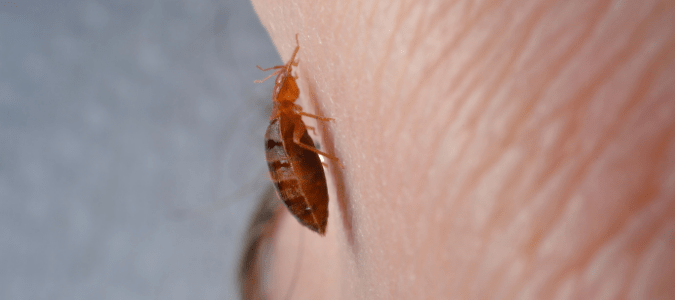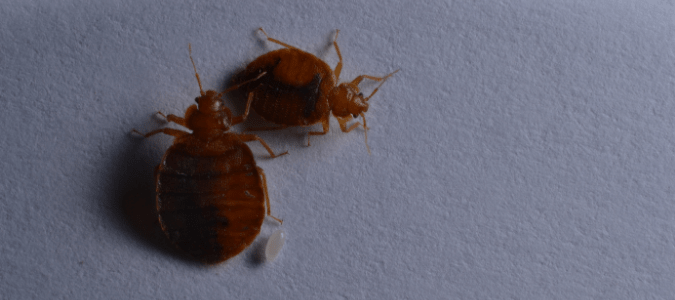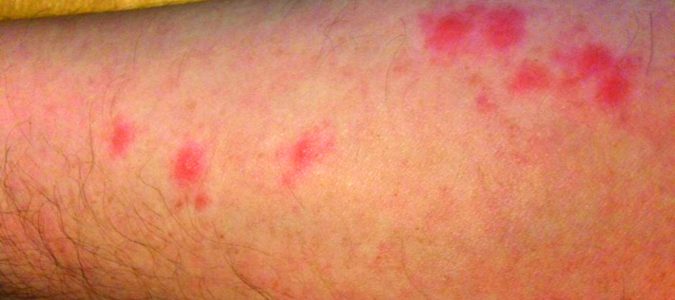Unfortunately for homeowners, in the last 20 years, there has been an uptick in bed bug populations. And, worse yet, they are becoming increasingly resistant to products on the market, which can make controlling an infestation even more difficult than before. Today, bed bugs can be found everywhere. They aren’t isolated to dense population areas or hotels where people come and go a lot.
How Bed Bugs Get In Your Home
It’s easier to bring home bed bugs than one may think. Bed bugs aren’t just isolated to bedrooms. These pests have been found on airplanes, in movie theaters and on public transportation. When you visit a place that has bed bugs, these creatures can crawl into your luggage or other bags and travel home with you. Unfortunately, once bed bugs find their way into your home, their populations can quickly grow.
Bed bugs are tiny. When they are fully grown, they look a lot like apple seeds. They hide during the day wherever they can find dark conditions. Bed bugs will hide behind baseboards, in box springs, under the mattress or your pillows, under bedside tables or anywhere dark and out of the way.
Females lay as many as seven eggs per day in optimum temperatures (which happen to be the same temperatures we enjoy). The female has to ingest blood for her eggs to develop, and a single meal can yield 20 eggs laid.
How Many Bed Bugs Are in One Egg?
Bed bug eggs are very difficult to spot. They’re cream-colored and not much larger than the period at the end of this sentence. Unlike cockroaches, which lay egg cases containing upwards of 16 eggs each, bed bug eggs are laid individually, with one bed bug per egg. They aren’t laid anywhere special, either; the mother lays them wherever she happens to be. A female bed bug can lay about 113 eggs in her lifetime, and 97% of her eggs will hatch in optimal conditions.
When the eggs hatch after a few days, a bed bug nymph appears and must find a host to feed on. Bed bugs don’t consume anything but blood. They find a blood meal one of two ways. Bed bugs can smell carbon dioxide from your breath, but only if they’re within a few feet of your face. They can sense your heat too, but they have to be even closer to pick you up that way. If they don’t find a host, they’ll settle for a dark place to lay until night.
Each nymph will shed its exoskeleton five times, and another meal precedes each shedding. So each bed bug will bite five times before they become an adult. After that, they’ll bite you or your family every week or so. However, if conditions are right, bed bugs can go months without feeding. Given all of these facts, it’s easy to see that bed bugs are not something to deal with halfway. You need pest control professionals to handle a bed bug infestation. These professionals have the tools and strategies needed to locate bed bug hiding spots and treat them properly.
Bed Bug Blood Stains
Often the first sign that you have a bed bug problem isn’t visible bites on you but spots on your bedding. Tiny dark brown or reddish dots around the pillowcase or at the foot of the bed should always raise alarms. Those are fecal deposits from the bed bugs heading back to their hideouts after feeding on you and your family. If you have dark bedding and can’t see any spots, take off your sheets to examine your mattress and pillows to see if you have any spots there.
You might also find the yellowish exoskeletons shed by young bed bugs after eating. Or, you might see larger bloody spots caused by bed bugs being crushed while feeding. You likely won’t see live bed bugs unless you are actively searching for them. They tend to feed while we are sleeping. Typically, bed bugs are back in their hiding places by the time you get up in the morning.
If you suspect these pests are in your home, you can start by knowing how to inspect for bed bugs. First, pull back the bedding and check things like the large seams around the edges of the mattress or lift the mattress and look at the box springs. There you may find live bed bugs, blood spots and shed exoskeletons. If you do, it’s important to contact pest control professionals to treat the infestation.
What Do Bed Bug Bites Look Like on Arms?
Oddly enough, you may discover your bed bug problems before you notice any signs that you or your family have been bitten. Some members of your household may not react to bites at all! Other homeowners may notice they are getting bitten at night but don’t see signs of bed bugs.
The bites themselves are painless due to an anesthetic bed bugs inject when they bite, and they may leave no mark on the skin. Bites may start to show up after a week or two. They can look like insect bites and are sometimes mistaken as mosquito or spider bites. They can also appear faint, like eczema, a fungal infection, or a rash like poison ivy, without any specific bite points being visible. Some people show no signs of bites at all; others can have significant allergic reactions at bite sites. Blisters are rare but do appear on some people.
Bed bugs bite exposed skin, so you’re most likely to find bites on your face, arms, hands, legs and feet. They usually appear in a zig-zag pattern, or the bites might resemble the dots on a domino.
Over time, your body may adjust to the bed bug bites and you may stop reacting entirely. If this happens, it doesn’t mean the bed bug infestation went away. You will still need to contact a pest control professional to treat your bed bug problem.
Why Bed Bugs Are Difficult To Control
Bed bugs are incredibly well-adapted to live with humans. Their tiny size and ability to hide make them difficult to spot. These pests can even fit in crevices the width of a credit card.
Bed bugs have another advantage. Any mated female removed from an area with many bed bugs, like when she catches a ride home in your luggage, will ramp up her egg-laying once she finds meals in an area with less competition. That means a single female bed bug can build up a new population in your home faster than she otherwise would. Bed bugs can double their population every two weeks.
Bed bugs start off as a small problem, so small you don’t even realize you have a problem for a while. But when you spot the signs of bed bugs, they may already be well established.
Pest control professionals have effective treatment options to address bed bug infestations. Licensed professionals can get results with bed bugs that homeowners simply can’t match.
ABC Can Control Your Bed Bug Problem
Bed bugs are annoying pests that are hard to control on your own. When you notice an infestation, contact ABC Home & Commercial Services for pest control services. We have multiple strategies to control bed bugs, so you and your family can be comfortable again.



